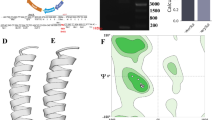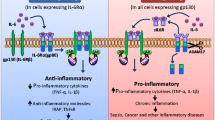Abstract
For the past ten years, our research has been focused on elucidating the mechanism by which procathepsin D (pCD) impacts cancer development. Various studies have shown that pCD is overexpressed and secreted by numerous cancer cell lines. After secretion, it exhibits “growth hormone-like” activity on cancerous cells but the exact mechanism of this mitogenic activity is not yet understood. The activation peptide of pCD (APpCD) (which is cleaved off upon activation of the zymogen) is responsible for the mitogenic function of pCD. Variousin vitro andin vivo studies support our theory that the APpCD interacts with both parent and neighborhood cancer cells and thus functions as an autocrine mitogen. We propose a model of pCD mitogenic function and also some possible approaches for treatment and prevention of certain types of cancer.
Similar content being viewed by others
Abbreviations
- CD:
-
cathepsin D
- pCD:
-
procathepsin D
- Man-6-P :
-
mannose 6-phosphate
- APpCD:
-
activation peptide of pCD
References
Bazzett L.B., Watkins C.S., Gercel-Taylor C., Taylor D.D.: Modulation of proliferation and chemosensitivity by procathepsin D and its peptides in ovarian cancer.Gynecol.Oncol. 74, 181–187 (1999).
Beneš P., Koelsch G., Dvořák B., Fusek M., Větvička V.: Detection of procathepsin D in rat milk.Comp.Biochem.Physiol. B 133, 113–118 (2002).
Brouillet J.P., Dufour F., Lemamy G., Garcia M., Schlup N., Grenier J., Mani J.C., Rochefort H.: Increased cathepsin D level in the serum of patients with metastatic breast carcinoma detected with a specific pro-cathepsin D immunoassay.Cancer 79, 2132–2136 (1997).
Cavailles V., Augreau P., Rochefort H.: Cathepsin D gene is controlled by a mixed promoter, and estrogens stimulate only TATA-dependent transcription in breast cancer cells.Proc.Nat.Acad.Sci.USA 90, 203–207 (1993).
Chambon M., Rebillard X., Rochefort H., Brouillet J.P., Baldet P., Guiter J., Maudelonde T.: Cathepsin D cytosolic assay and immunohistochemical quantification in human prostate tumors.Prostate 24, 320–325 (1994).
Chinni S.R., Gercel-Taylor C., Conner G.E., Taylor D.D.: Cathepsin D antigenic epitopes identified by the humoral responses of ovarian cancer patients.Cancer Immunol.Immunother. 46, 48–54 (1998).
Elangovan S., Moulton B.C.: Blastocyst implantation in the rat and the immunohistochemical distribution and rate of synthesis of uterine lysosomal cathepsin D.Biol.Reprod. 23, 663–668 (1980).
Ferrandina G., Scambia G., Panici P., Alamdori G., Paludetti G., Cadoni G., Distefano M., Maurizi M., Mancuso S.: Cathepsin D in primary squamous laryngeal tumors: correlation with clinico-pathological parameters and receptor status.Cancer Lett. 67, 133–138 (1992).
Freudenheim J.L., Marshall J.R., Graham S., Laughlin R., Vena J.E., Bandera E., Muti P., Swanson M., Nemoto T.: Exposure to breastmilk in infancy and the risk of breast cancer.Epidemiology 5, 324–331 (1994).
Fusek M., Větvička V.: Mitogenic function of human procathepsin D: the role of the propeptide.Biochem.J. 303, 775–780 (1994).
Fusek M., Větvička V.:Aspartic Proteinases: Physiology and Pathology. CRC Press, Boca Raton 1995.
Garcia M., Dercoq D., Pujol P., Rochefort H.: Overexpression of transfected cathepsin D in transformed cells increases their malignant phenotype and metastatic potency.Oncogene 5, 1809–1814 (1990).
Glondu M., Coopman P., Laurent-Matha V., Garcia M., Rochefort H., Liaudet-Coopman E.: A mutated cathepsin-D devoid of its catalytic activity stimulates the growth of cancer cells.Oncogene 20, 6920–6929 (2001).
Glondu M., Liaudet-Coopman E., Derocq D., Platet N., Rochefort H., Garcia M.: Down-regulation of cathepsin-D expression by antisense gene transfer inhibits tumor growth and experimental lung metastasis of human breast cancer cells.Oncogene 21, 5127–5134 (2002).
Huet G., Zerimech F., Dieu M.C., Hemon B., Grard G., Balduyck M., Janin A., Lafyatis R., Degand P.: The state of differentiation of HT-29 colon carcinoma cells alters the secretion of cathepsin D and of plasminogen activator.Internat.J.Cancer 57, 875–882 (1994).
Johnson M.D., Torri J.A., Lippman M.E., Dickson R.B.: The role of cathepsin D in the invasiveness of human breast cancer cells.Cancer Res. 53, 873–877 (1993).
Koelsch G., Metcalf P., Větvička V., Fusek M., p. 273 inAspartic Proteinases: Structure, Function, Biology, and Biomedical Implications (K. Takahashi, Ed.). Plenum Press, New York 1995.
Kute T.E., Shao Z.M., Sugg N.K., Long R.T., Russell G.B., Case D.: Cathepsin D as a prognostic indicator for node-negative breast cancer patients using both immunoassays and enzymatic assays.Cancer Res. 52, 5198–5203 (1992).
Lah T.T., Calaf G., Kaiman E., Shinde B.G., Russo J., Jarosz D., Zabrecky J., Somers R., Daskal I.: Cathepsins D. B and L in breast carcinoma and in transformed human breast epithelial cells (HBEC).Biol.Chem.Hoppe-Seyler 376, 357–363 (1995).
Larsen L.B., Boisen A., Petersen T.E.: Procathepsin D cannot autoactivate to cathepsin D at acid pH.FEBS Lett. 319, 54–58 (1993).
Laury-Kleintop L.D., Coronel E.C., Lange M.K., Tachovsky T., Longo S., Tucker S., Alhadeff J.A.: Western blotting and isoform analysis of cathepsin D from normal and malignant human breast cell lines.Breast Cancer Res.Treat. 35, 211–220 (1995).
Leto G., Gebbia N., Rausa L., Tumminello F.M.: Cathepsin D in the malignant progression of neoplastic diseases.Anticancer Res. 12, 235–240 (1992).
Leto G., Tumminello F.M., Crescimanno M., Flandina C., Gebbia N.: Cathepsin D expression levels in nongynecological solid tumors: clinical and therapeutic implications.Clin.Exp.Metastasis 21, 91–106 (2004).
Metaye T., Millet C., Kraimps J.L., Aubouin B., Barbier J., Begon F.: Estrogen receptors and cathepsin D in human thyroid tissue.Cancer 72, 1991–1996 (1993).
Metcalf P., Fusek M.: Two crystal structures for cathepsin D: the lysosomal targeting signal and active site.EMBO J. 12, 1293–1302 (1993).
Nazeer T., Church K., Amato C., Ambros R.A., Rosano T.G., Malfetano J.H., Ross J.S.: Comparative quantitative immunohistochemical and immunoradiometric determinations of cathepsin D in endometrial adenocarcinoma: predictors of tumor aggressiveness.Modern Pathol. 7, 469–474 (1994).
Parker L.: Breast-feeding and cancer prevention.Eur.J.Cancer 37, 155–158 (2001).
Podhajcer O.L., Bover L., Bravo A.L., Ledda M.F., Kairiyama C., Calb I., Guerra L., Capony F., Mordoh J.: Expression of cathepsin D in primary and metastatic human melanoma and dysplastic nevi.J.Invest.Dermatol. 104, 340–344 (1995).
Pujol P., Maudelonde T., Daures J.P., Rouanet P., Brouillet J.P., Pujol H., Rochefort H.: A prospective study of the prognostic value of cathepsin D levels in breast cancer cytosol.Cancer 71, 2006–2012 (1993).
Reid W.A., Vallor M.J., Kay J.: Immunolocalization of cathepsin D in normal and neoplastic human tissues.J.Clin.Pathol. 39, 1323–1330 (1986).
Rochefort H., Capony F., Garcia M., Cavailles V., Freiss G., Chambon M., Morisset M., Vignon F.: Estrogen-induced lysosomal proteases secreted by breast cancer cells: a role in carcinogenesis?J.Cell.Biochem. 35, 17–29 (1987).
Rochefort H.: Cathepsin D in breast cancer: a tissue marker associated with metastasis.Eur.J.Cancer 28A, 1780–1783 (1992a).
Rochefort H.: Biological and clinical significance of cathepsin D in breast cancer.Acta Oncol. 31, 125–130 (1992b).
Rochefort H.: Estrogen-induced genes in breast cancer, and their medical importance.Bull.Acad.Nat.Med. 183, 955–968 (1999).
Schultz D.C., Bazel S., Wright L.M., Tucker S., Lange M.K., Tachovsky T., Longo S., Niedbala S., Alhadeff J.A.: Western blotting and enzymatic activity analysis of cathepsin D in breast tissue and sera of patients with breast cancer and benign breast disease and of normal controls.Cancer Res. 54, 48–54 (1994).
Spyratos F., Brouillet J.P., Defrenne A., Hacene K., Rouesse J., Maudelonde T., Brunet M., Andrieu C., Desplaces A., Rochefort H.: Cathepsin D: an independent prognostic factor for metastasis of breast cancer.Lancet 2, 1115–1118 (1989).
Tang J., Wong R.N.S.: Evolution in the structure and function of aspartic proteases.J.Cell.Biochem. 33, 53–63 (1987).
Taylor D.D., Gercel-Taylor C.: Tumor-reactive immunoglobulins in ovarian cancer: diagnostic and therapeutic significance?Oncol.Rep. 5, 1519–1524 (1998).
Tedone T., Correale M., Barbadossa G., Casavola V., Paradiso A., Reshkin S.J.: Release of the aspartyl protease cathepsin D is associated with and facilitates human breast cancer cell invasion.FASEB J. 11, 785–792 (1997).
Větvička V., Vagner J., Baudyš M., Tang J., Foundling S.I., Fusek M.: Human breast milk contains procathepsin-D detection by specific antibodies.Biochem.Mol.Biol.Internat. 30, 921–928 (1993).
Větvička V., Větvičkova J., Hilgert I., Vobůrka Z., Fusek M.: Analysis of the interaction of procathepsin D activation peptide with breast cancer cells.Internat.J.Cancer 73, 403–409 (1997).
Větvička V., Větvičkova J., Fusek M.: Effect of procathepsin D and its activation peptide on prostate cancer cells.Cancer Lett. 129, 55–59 (1998).
Větvička V. Větvičková J., Fusek M.: Anti-human procathepsin D activation peptide antibodies inhibit breast cancer development.Breast Cancer Res.Treat. 57, 261–269 (1999).
Větvička V., Větvičkova J., Fusek M.: Role of procathepsin D activation peptide in prostate cancer growth.Prostate 44, 1–7 (2000).
Větvička V., Beneš P., Fusek M.: Procathepsin D in breast cancer: what do we know? Effects of ribozymes and other inhibitors.Cancer Gene Ther. 9, 854–863 (2002).
Westley B., Rochefort H.: A secreted glycoprotein induced by estrogen in human breast cancer cell lines.Cell 20, 353–362 (1980).
Author information
Authors and Affiliations
Corresponding author
Rights and permissions
About this article
Cite this article
Vashishta, A., Fusek, M. & Větvička, V. Possible role of procathepsin D in human cancer. Folia Microbiol 50, 71–76 (2005). https://doi.org/10.1007/BF02931296
Received:
Issue Date:
DOI: https://doi.org/10.1007/BF02931296




